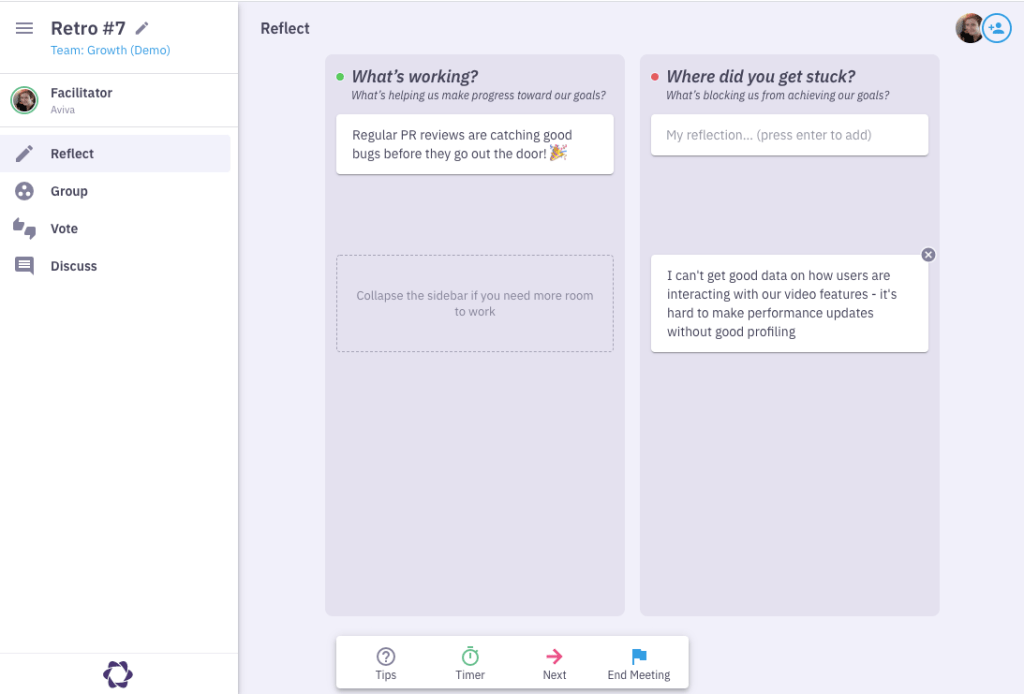Working and Stuck
Identify what’s holding you back as a team with this simple retrospective

What is a Working & Stuck retrospective?
The Working and Stuck retrospective is one of the simplest retrospective templates, but that doesn’t mean it’s any less useful than the others. In fact, the simplicity could be just the thing your team needs to jumpstart productivity or pull out of a rut.
What are the Working & Stuck retro prompts?
Here’s how the two categories break down:
🚗 Working
Think of this like the “Continue” category in the Start, Stop, Continue retro. These are the things currently working. Remember, this doesn’t necessarily have to be positive. Your car might be a week overdue for an oil change, but it still works. This isn’t the retro that worries about low wiper fluid. Focus on the things that are working (positive, neutral, even sliding into negative) and that will continue to work in the next sprint or project.
Example: Having stakeholders leave comments directly in our mock ups keeps feedback organized and makes it easier to implement
⛔️ Stuck
This is the flat tire, the mud you can’t get out of, the broken transmission or dead battery. In this category you put the things that blocked progress and dramatically reduced efficiency. These are things that literally got you stuck, or will have the potential to do so if they aren’t addressed before the next sprint or project. You’ll find things to add to the Stuck category by thinking back to missed deadlines, scheduling conflicts, or incomplete tickets.
Example: Limits on our licenses for the stock photography site meant we couldn’t source imagery as quickly as we should have
Benefits of a Working & Stuck retrospective
Here are a few reasons why you might want to pick this meeting type!
It’s simple
The simplicity of a Working & Stuck retrospective is what makes it useful. Because things in the “working” category don’t necessarily have to be positive, you could end up with a lot of issues, and while they do need to be addressed eventually, they’re currently working—they’re not stuck.
It helps you balance the good and the bad (and the ugly)
So if you’re going to acknowledge the possibly bad, but not address it, why not do a retro that’s just Stuck? Because it helps to have a balance of the good and bad, and to acknowledge what is (and isn’t) working. It’s especially useful if you run this retro again. Then you can see if any of those neutral or slightly negative issues in Working have slid to Stuck.
It focuses on forward movement
As for the things currently in stuck, your team will likely know almost immediately what needs to change before the next sprint. Typically the things that are stuck are pretty easy to identify. Everyone remembers when the project came to a grinding halt. If things never really stopped dead in their tracks, you can instead look for things that slowed the team down (or had the potential to do so).
We’ve used a lot of vehicle metaphor here and it’s for good reason—the Working & Stuck retrospective can feel a lot like car trouble. Think of your team as the passengers, who also happen to be handy mechanics. As you run the retro, imagine everyone out of the car kicking the tires, diagnosing potential problems. You can all identity problems, and because you’re all mechanics, you can fix them too!
One thing to watch out for in this retrospective is the possibility of putting off problems. You might be able to drive your car for days, weeks, even months after the “check engine” light comes on, but you probably shouldn’t. It’s a good idea to flag some of those “working” issues that could eventually become “stuck” issues so you can address them with another retro down the road.
When to do a Working & Stuck retrospective
A lot of people run a Working & Stuck retro after their team…gets stuck. If a process or project hobbled across the finish line (or didn’t finish at all), it might be a good time to look back on what’s working and what isn’t.
When you’ve experienced roadblocks and detours
If you got done with an event, project or sprint and hit some roadblocks and detours along the way, it’s helpful to examine how and why you hit those wrong turns. Were you stuck because of something in your control? If not, what can your team do to mitigate those issues in the future? If you were stuck because of things in your control, identify those things and work together to change them.
When things have broken down
Whether it’s due to a new process, new software, or new team dynamics, sometimes things just don’t go as planned. If there’s a complete breakdown, it can be helpful to assess what was working. You might not need to scrap everything! You can call this the “glass half full” version of Working & Stuck retros. Unifying around the parts that did actually work can help boost team morale after a severe breakdown.
Dealing with a complete disaster isn’t a prerequisite for a Working and Stuck retro, you can run one if your team wasn’t badly stuck and you still want to assess what’s working. The easy categorization means you can get through one relatively quickly if you just want to run it as a quick spot check for your team.
How to run a Working & Stuck retrospective with Parabol
First of all, jump into Parabol. If you’re a Scrum Master or the team meeting facilitator hit the vibrant Add New Meeting button.
If you’re doing an Icebreaker, you’ll have a random question to answer. You can refresh it if you want another option, and of course you can create your own if you want.
After the Icebreaker you’ll move on to the reflect stage. This is where you get into the principles of the Working & Stuck retro discussed above.

Remember, Parabol is remote-friendly, enabling you to work asynchronously with your team. They can all leave comments together, or do it at a time that works for them. Also, reflections are anonymous, and no one can see them until you’re done working on them.
After the reflect phase, you’ll vote on issues to discuss, talk about the most voted on items, and then get a summary of the retro when you’re done. Make sure to review the retro 101 guide for tips on running a retrospective smoothly.